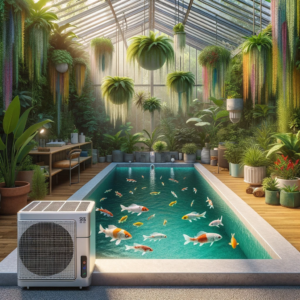Wondering how long it takes to cool down a cold plunge? With American Chillers, you can cool your cold plunge pool or tub down as fast a 30 minutes or as long as several hours.
Understanding the Cooling Down Process: Timeframes and Expectations
Cold plunge pools have become a staple in luxury spas, wellness centers, and high-end properties, known for their therapeutic benefits and invigorating experience. However, one crucial aspect that often gets overlooked is the cool down process — how long it takes to cool the water to the desired temperature. American Chillers, a leader in chiller technology, is here to shed light on this process, providing insights for contractors and clients alike.
The Science Behind Cooling Down Water: Cooling down a large body of water is not an instantaneous process. It involves removing heat from the water, which depends on several factors, including the volume of water, the starting and desired temperatures, and the ambient temperature. AmChiller’s advanced chillers are designed to optimize this process, ensuring efficient cooling while maintaining energy efficiency.
Factors Affecting Cooling Time: Several factors influence the time it takes for a cold plunge pool to reach the optimal temperature:
- Water Volume: Larger pools require more time to cool down due to the greater amount of water.
- Starting Temperature: The higher the initial temperature of the water, the longer the cooling process will take.
- Desired Temperature: The degree of coolness desired also plays a role. A lower temperature setting will naturally require more cooling time.
- Ambient Temperature: The surrounding environment can impact the cooling process. Warmer ambient temperatures can slow down the cooling process.
- Chiller Capacity: The capacity and efficiency of the chiller directly affect how quickly it can cool the water.
- Heat Gain: The heat that is being added to your cold plunge system from long pipe runs, uninsulated pipes, pumps, solar load, uncovered tubs/pools, etc. will affect the time it takes to cool down your cold plunge.
Typical Cooling Timeframes: While it’s challenging to provide a one-size-fits-all timeframe due to the variables involved, most high-quality systems like those offered by American Chillers can cool a standard-sized plunge pool from 85°F to 55°F between 4 to 8 hours. However, these times can vary based on the specific conditions and requirements of each installation.
Maximizing Efficiency: To ensure the most efficient cooling process, American Chillers recommends:
- Proper Sizing: Ensuring the chiller is appropriately sized for the pool volume and intended use.
- Regular Maintenance: Keeping the chiller well-maintained to ensure it operates at peak efficiency.
- Insulation: Properly insulating the pool and the surrounding area to minimize heat gain from the environment.
Advanced Features for Better Control: American Chiller’s cold plunge pool chillers can work with on-site pool automation systems from Jandy or Pentair and Hayward which provide advanced features like programmable thermostats and remote monitoring, allowing for precise control over the cooling process. This technology not only improves efficiency but also provides convenience and ease of use.
Conclusion: Understanding the cool down process in cold plunge pools is essential for both contractors and clients. With American Chiller’s advanced chilling solutions, you can be assured of an efficient and reliable process, tailored to meet the specific needs of your luxury spa or wellness center.
Call to Action: Planning to install a cold plunge pool or looking to upgrade your chilling system? Contact our cold plunge experts at American Chillers today to explore the best solutions for your needs and ensure your customers and guests enjoy the perfect plunge every time.



